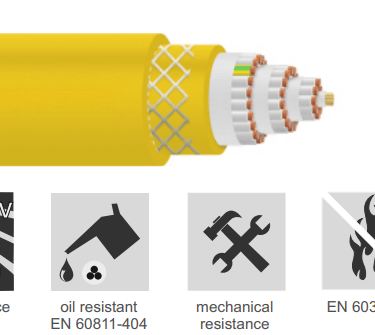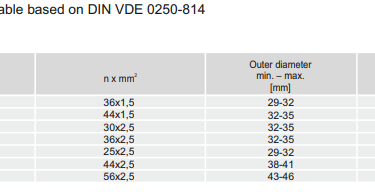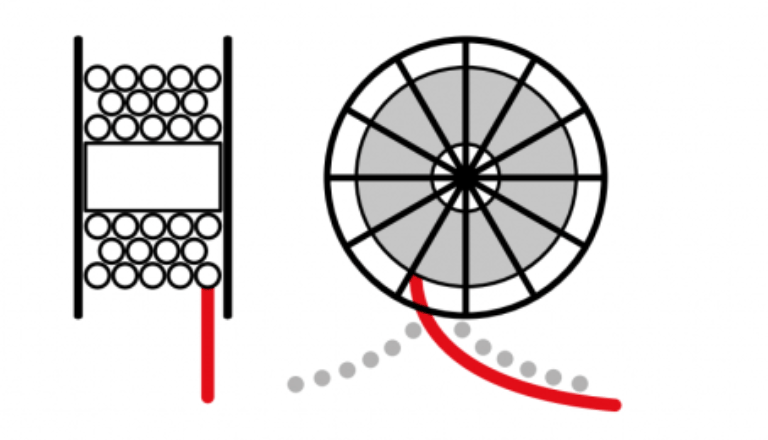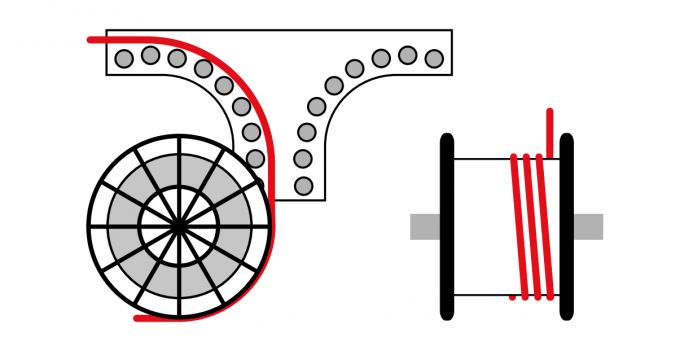📞+86 153 7530 2641 📧 hongjing.Wang@feichuncables.com

Heavy Duty Rubber Reeling Cable (N)SHTOEU-J SPREADER for Ship-to-Shore Cranes: Vertical Drum-Spreader Systems Cable Solutions
Discover the (N)SHTOEU-J SPREADER heavy duty rubber reeling cable—engineered for ship-to-shore cranes and vertical drum-spreader systems. High tensile load capacity, UV/oil resistance, and –50°C to 80°C performance ensure reliable hoist operations.
hongjing.Wang@Feichun
8/4/202510 min read


Introduction
Overview of (N)SHTOEU-J SPREADER Cable
The (N)SHTOEU-J SPREADER represents a pinnacle in heavy duty rubber reeling cable engineering, specifically designed to meet the demanding requirements of modern port infrastructure and industrial hoisting applications. This low voltage reeling cable, manufactured in accordance with DIN VDE 0250-814 standards, delivers exceptional performance in environments where conventional cables simply cannot withstand the mechanical stresses and environmental challenges.
Built with a robust construction featuring extra heavy duty rubber compounds and reinforced synthetic thread braiding, this cable stands as the preferred solution for professionals operating ship-to-shore crane spreaders and vertical drum-spreader systems. The cable's unique design philosophy centres around providing maximum reliability whilst maintaining the flexibility essential for continuous reeling operations.
Importance in Ship-to-Shore Crane and Hoisting Systems
In the demanding environment of modern container terminals, ship-to-shore cranes represent critical infrastructure that cannot afford downtime. These massive structures require cable systems that can withstand not only the mechanical stresses of constant vertical movement but also the harsh maritime environment characterised by salt spray, temperature fluctuations, and UV exposure. The (N)SHTOEU-J SPREADER cable addresses these challenges through its specialised construction and material selection.
Vertical drum-spreader hoisting systems present unique challenges that standard cables simply cannot address effectively. The combination of high tensile loads, torsional stresses, and environmental exposure requires a cable solution engineered specifically for these applications. When container handling equipment fails due to cable issues, the resulting delays can cost ports thousands of dollars per hour, making reliability paramount.
Key Features & Benefits
High Mechanical Stress Resistance
The (N)SHTOEU-J SPREADER cable excels in applications requiring exceptional mechanical durability. Its construction incorporates plain copper conductors with Class 5 fine stranding according to IEC 60228, providing superior flexibility whilst maintaining excellent electrical conductivity. The cable can withstand torsional stresses of ±50°/m, significantly exceeding the requirements of most vertical drum applications.
The multi-core stranded layer arrangement distributes mechanical stresses evenly throughout the cable structure, preventing localised stress concentrations that often lead to premature failure in conventional cables. This design philosophy ensures consistent performance even under the most demanding operational conditions.
Superior Tensile Load Capacity for Vertical Drums
One of the most critical aspects of the (N)SHTOEU-J SPREADER is its exceptional tensile load capacity. With static tensile strength of 15 N/mm² and dynamic tensile strength reaching 30 N/mm², this cable can handle the substantial loads imposed by vertical drum-spreader systems on ship-to-shore cranes. This superior tensile capacity stems from the cable's reinforced construction, featuring a synthetic thread braid that forms a vulcanised bond between the inner and outer sheaths.
This reinforcement system distributes tensile loads across the entire cable cross-section, preventing conductor damage and maintaining electrical integrity even under maximum load conditions. For operators of motor-driven and spring-operated reels, this translates to reduced maintenance requirements and extended operational life.
UV, Oil, Ozone, and Moisture Resistance
The maritime environment presents numerous chemical and environmental challenges that can rapidly degrade conventional cable systems. The (N)SHTOEU-J SPREADER addresses these concerns through its extra heavy duty rubber compound outer sheath, manufactured to Type 5GM5 specifications according to DIN VDE 0207-21. This formulation provides exceptional resistance to oil contamination, a common issue in industrial hoisting environments.
UV resistance ensures the cable maintains its mechanical and electrical properties despite prolonged exposure to sunlight, whilst ozone resistance prevents the rubber degradation commonly experienced in coastal environments. The cable's moisture resistance properties make it suitable for unrestricted outdoor use, eliminating concerns about water ingress that can compromise electrical safety and performance.
Wide Temperature Range Performance
Temperature extremes present significant challenges for cable systems in industrial applications. The (N)SHTOEU-J SPREADER demonstrates remarkable temperature stability, operating reliably in fixed installations from -50°C to 80°C, with reeling operation capability from -35°C to 80°C. This wide temperature range ensures consistent performance across diverse climatic conditions and seasonal variations.
The cable's HEPR (Hard Ethylene Propylene Rubber) insulation compound, manufactured according to IEC 60502-1 standards, maintains its electrical properties across this entire temperature range. The maximum permissible conductor temperature of 90°C provides additional safety margin, whilst the short-circuit temperature rating of 250°C ensures safe operation even under fault conditions.
Technical Specifications
Rated Voltage: 0.6/1 kV (AC) and 0.9/1.8 kV (DC)
The (N)SHTOEU-J SPREADER operates at a rated voltage of 0.6/1 kV for AC applications, with maximum permissible operating voltage of 0.7/1.2 kV. For DC systems, the cable handles 0.9/1.8 kV operation, making it suitable for a diverse range of electrical systems commonly found in port and industrial applications. The AC test voltage of 3.5 kV provides substantial safety margin above normal operating conditions.
These voltage ratings accommodate the power requirements of modern ship-to-shore crane spreaders whilst maintaining appropriate safety margins. The cable's electrical design incorporates colour-coded cores according to DIN VDE 0293-308, with ground conductors featuring the standard green-yellow identification for enhanced safety compliance.
Conductor: Class 5 Flexible Copper Construction
The cable incorporates finely stranded plain copper conductors manufactured to IEC 60228 Class 5 specifications, representing the highest flexibility class available for power cables. This fine stranding provides exceptional flexibility essential for continuous reeling applications whilst maintaining excellent electrical conductivity. The conductor design withstands the repeated flexing inherent in vertical drum-spreader systems without work hardening or strand breakage.
Each conductor features HEPR insulation that provides excellent electrical properties whilst maintaining mechanical flexibility. The core arrangement utilises multi-core stranding in layers, optimising the cable's overall flexibility whilst ensuring uniform stress distribution during bending and reeling operations.
Insulation & Sheath: Advanced Rubber Compounds
The cable's insulation system employs HEPR compound meeting IEC 60502-1 requirements, providing excellent electrical properties and mechanical durability. The inner sheath utilises extra heavy duty rubber compound Type 5GM5 according to DIN VDE 0207-21, filling interstices and providing additional mechanical protection.
The reinforcement system features synthetic thread braiding in vulcanised bond configuration between inner and outer sheaths, creating a unified structure that distributes mechanical stresses effectively. The outer sheath, also manufactured from Type 5GM5 compound, provides the primary defence against environmental contamination whilst maintaining flexibility essential for reeling operations.
Mechanical Parameters: Superior Performance Metrics
The cable's mechanical design accommodates torsional stresses of ±50°/m, well within the operational requirements of vertical drum systems. Bending radius specifications vary according to application: fixed installation requires ≥4× cable diameter, reeling applications need ≥6× cable diameter, and deflection pulleys require ≥7.5× cable diameter. For S-type directional changes, the minimum distance requirement is 20× cable diameter.
Maximum reeling speed capability reaches 240 m/min, accommodating the operational requirements of high-speed container handling equipment. These mechanical parameters reflect careful engineering optimisation for the specific demands of ship-to-shore crane and vertical drum-spreader applications.
Fire Performance: IEC 60332-1-2 Compliance
Fire safety represents a critical consideration in port environments where cable failures can have catastrophic consequences. The (N)SHTOEU-J SPREADER meets IEC 60332-1-2 flame retardant requirements, ensuring controlled fire behaviour that limits flame propagation. This compliance provides essential safety protection whilst maintaining the cable's mechanical and electrical performance characteristics.
The cable's fire performance characteristics complement its environmental resistance properties, creating a comprehensive safety profile suitable for the most demanding industrial applications. Regular testing ensures continued compliance with evolving safety standards and regulatory requirements.




Typical Applications
Ship-to-Shore Crane Spreaders
Ship-to-shore cranes represent the backbone of modern container terminal operations, with spreaders requiring reliable power delivery systems that can withstand the unique stresses of vertical lifting operations. The (N)SHTOEU-J SPREADER cable provides the robust power transmission solution these critical systems demand, with construction specifically optimised for the high tensile loads and environmental exposure characteristic of crane operations.
The cable's yellow outer sheath with inkjet marking provides excellent visibility for safety compliance whilst the robust construction ensures reliable operation despite the challenging maritime environment. Container terminal operators benefit from reduced maintenance requirements and extended operational life compared to conventional cable solutions.
Vertical Drum-Spreader Hoisting Systems
Vertical drum-spreader systems present unique engineering challenges that require specialised cable solutions. The combination of high tensile loads, continuous reeling action, and environmental exposure demands cables engineered specifically for these applications. The (N)SHTOEU-J SPREADER addresses these requirements through its reinforced construction and superior material selection.
The cable's synthetic thread reinforcement system distributes tensile loads effectively, preventing the conductor damage and insulation failure commonly experienced with conventional cables in vertical hoisting applications. This design philosophy ensures consistent electrical performance even under maximum mechanical stress conditions.
Motor-Driven and Spring-Operated Reels
Both motor-driven and spring-operated reel systems benefit from the (N)SHTOEU-J SPREADER's superior mechanical properties and electrical performance. The cable's flexibility enables smooth reeling action whilst its tensile strength accommodates the loads imposed by spring-operated systems. Motor-driven applications benefit from the cable's excellent electrical characteristics and temperature stability.
The cable's construction accommodates the repetitive flexing inherent in reel operations without degradation, ensuring extended operational life and reduced maintenance requirements. This reliability translates to improved operational efficiency and reduced lifecycle costs for equipment operators.


Installation & Maintenance Tips
Minimum Bending Radius Guidelines
Proper installation requires strict adherence to minimum bending radius specifications to ensure optimal cable performance and longevity. For fixed installations, maintain bending radii of at least four times the cable's outer diameter. Reeling applications require minimum bending radii of six times the cable diameter, whilst deflection pulleys demand 7.5 times the cable diameter.
S-type directional changes present particular challenges and require minimum spacing of 20 times the cable diameter between direction changes. These specifications reflect careful engineering analysis of stress distribution and ensure the cable operates within safe mechanical limits throughout its operational life.
Storage, Handling, and Drum Mounting Best Practices
Proper storage protects the cable's performance characteristics prior to installation. Store cables in dry, temperature-controlled environments, avoiding direct sunlight exposure that can degrade rubber compounds over time. When handling, avoid excessive bending or kinking that can damage internal conductors or compromise insulation integrity.
Drum mounting requires careful attention to tension distribution and support systems. Ensure adequate drum capacity to prevent excessive cable layering that can create pressure points and mechanical stress concentrations. Regular inspection of drum surfaces prevents abrasive wear that can compromise cable performance over time.
Regular Inspection for Wear and Tear
Preventive maintenance programmes should include regular visual inspection of cable condition, focusing on areas subject to mechanical stress such as drum contact points and directional changes. Look for signs of abrasion, cracking, or deformation that may indicate developing problems requiring attention.
Electrical testing should complement visual inspection, monitoring insulation resistance and conductor continuity to identify potential issues before they result in operational failures. Regular cleaning removes contaminants that can accelerate degradation, particularly in maritime environments where salt accumulation presents ongoing challenges.
Compliance & Standards
DIN VDE Standards Compliance
The (N)SHTOEU-J SPREADER cable demonstrates comprehensive compliance with relevant DIN VDE standards, including DIN VDE 0250-814 for reeling cable construction, DIN VDE 0293-308 for core colour coding, and DIN VDE 0207-21 for rubber compound specifications. This standards compliance ensures compatibility with European electrical installations and safety requirements.
DIN VDE 0298-3 bending radius requirements and DIN VDE 0298-4 de-rating factors provide the technical foundation for safe installation and operation. These standards reflect extensive industry experience and testing, providing confidence in the cable's performance characteristics and safety profile.
International Standards Recognition
The cable meets IEC 60228 Class 5 conductor requirements, IEC 60502-1 insulation standards, and IEC 60811-404 oil resistance specifications. EN 60811-404 and EN 60332-1-2 compliance ensures recognition across European markets whilst maintaining compatibility with international installation practices.
This comprehensive standards compliance facilitates specification and procurement processes whilst providing assurance of consistent quality and performance characteristics. Regular testing and certification maintenance ensure continued compliance with evolving standards and regulatory requirements.
CPR Certification
Construction Products Regulation (CPR) 305/2011 certification demonstrates the cable's compliance with European Union construction product requirements. This certification covers fire performance characteristics and ensures the cable meets the safety requirements for use in construction applications, including port infrastructure and industrial installations.
CPR certification simplifies specification processes for projects requiring regulatory compliance whilst providing additional assurance of product quality and performance. The certification process includes ongoing surveillance testing to ensure continued compliance throughout the product's lifecycle.
Conclusion
Summary of Advantages
The (N)SHTOEU-J SPREADER heavy duty rubber reeling cable represents a comprehensive solution for the demanding requirements of ship-to-shore crane and vertical drum-spreader applications. Its superior tensile load capacity, environmental resistance, and mechanical durability address the specific challenges presented by modern port infrastructure and industrial hoisting systems.
The cable's wide temperature range capability, oil and UV resistance, and flame retardant properties provide the reliability essential for critical infrastructure applications. Compliance with international standards ensures compatibility with diverse electrical systems whilst comprehensive testing validates performance claims.
How (N)SHTOEU-J SPREADER Optimises Uptime and Safety
By addressing the primary failure modes common to reeling cable applications, the (N)SHTOEU-J SPREADER significantly improves operational reliability and reduces maintenance requirements. Its robust construction withstands the mechanical stresses that frequently cause premature failure in conventional cables, whilst environmental resistance properties ensure consistent performance despite challenging operating conditions.
The cable's safety characteristics, including flame retardancy and comprehensive insulation systems, protect both equipment and personnel. For port operators and industrial facilities where downtime costs can reach thousands of dollars per hour, the (N)SHTOEU-J SPREADER provides the reliability essential for maintaining operational efficiency and profitability.




Frequently Asked Questions
Q: What makes the (N)SHTOEU-J SPREADER suitable for ship-to-shore crane applications? A: The cable's high tensile load capacity (30 N/mm² dynamic), superior environmental resistance, and construction optimised for vertical drum systems make it ideal for the demanding requirements of ship-to-shore crane spreaders.
Q: How does the cable handle oil contamination common in industrial environments? A: The extra heavy duty rubber compound sheath provides excellent oil resistance according to DIN EN/IEC 60811-404 standards, preventing degradation from hydraulic fluid and lubricant exposure.
Q: What temperature range can the cable withstand in reeling operations? A: The cable operates reliably from -35°C to 80°C in reeling applications, with conductor temperatures up to 90°C and short-circuit capability to 250°C.
Q: Is the cable suitable for both AC and DC systems? A: Yes, the cable handles 0.6/1 kV AC systems (maximum 0.7/1.2 kV) and 0.9/1.8 kV DC systems, accommodating diverse electrical requirements.
Q: What inspection maintenance is recommended? A: Regular visual inspection for wear, electrical testing for insulation resistance and conductor continuity, and cleaning to remove environmental contaminants, particularly in maritime applications.
How to Reach Us
Get in Touch
SiteMap
Product Catalogue
Reeling Cable
Festoon Cable
Shore Power Cable




Scan to add us on WeChat
